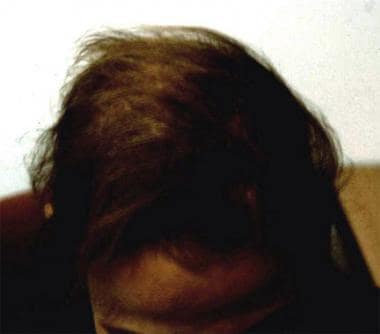Background
Telogen effluvium is a form of nonscarring alopecia characterized by diffuse hair shedding, often with an acute onset. [1] A chronic form with a more insidious onset and a longer duration also exists. [2, 3] Telogen effluvium is a reactive process caused by a metabolic or hormonal stress or by medications. Generally, recovery is spontaneous and occurs within 6 months, unless a background of pattern alopecia is present. [4]
Pathophysiology
Telogen effluvium can affect hair on all parts of the body, but, generally, only loss of scalp hair is symptomatic.
Understanding the pathophysiology of telogen effluvium requires knowledge of the hair growth cycle. All hair has a growth phase, termed anagen, and a resting phase, telogen. On the scalp, anagen lasts approximately 3 years, while telogen lasts roughly 3 months, although there can be wide variation in these times between individuals. During telogen, the resting hair remains in the follicle until it is pushed out by growth of a new anagen hair.
In most people, 5-15% of the hair on the scalp is in telogen at any given time. Telogen effluvium is triggered when a physiologic stress or hormonal change causes a large number of hairs to enter telogen at one time. Shedding does not occur until the new anagen hairs begin to grow. The emerging hairs help to force the resting hairs out of the follicle. Evidence suggests that the mechanism of shedding of a telogen hair is an active process that may occur independent of the emerging anagen hair. The interval between the inciting event in telogen effluvium and the onset of shedding corresponds to the length of the telogen phase, between 1 and 6 months (average 3 mo).
Headington has described 5 functional subtypes of telogen effluvium, based on which portion of the hair cycle is abnormally shortened or lengthened. [5] These subtypes represent variations on the principles discussed above. It is rarely possible to distinguish these subtypes clinically.
Etiology
Physiologic stress is the cause of telogen effluvium. These inciting factors can be organized into several categories, noted below. Evidence from mouse studies indicates that psychological stress can induce catagen, mainly by effects on neurotransmitters and hormones. [6] In humans, however, the role these effects play in hair loss has not yet been determined. While substance P has been extensively studies in human hair follicles in vitro, in vivo studies have not been performed. [7] In HIV disease, [8] apoptosis may be related to HIV-1 viral protein R. [9] Note the following causes:
-
Chronic illness such as malignancy, particularly lymphoproliferative malignancy; and any chronic debilitating illness, such as systemic lupus erythematosus, end-stage renal disease, or liver disease
-
Hormonal changes such as pregnancy and delivery (can affect both mother and child), hypothyroidism, and discontinuation of estrogen-containing medications [13] (see image below)
-
Changes in diet like crash dieting, anorexia, low protein intake, and chronic iron deficiency [14, 15, 16, 17] : A study by Olsen et al sought to determine if iron deficiency played a role in female pattern hair loss. Results indicated that iron deficiency is common in women but is not significantly increased in patients with female patterns of hair loss or chronic telogen effluvium when compared with control subjects. [18]
-
Allergic contact dermatitis of the scalp [22]
-
Psychological stress [17]
Epidemiology
Frequency
This condition is quite common, but exact prevalence is not recorded. A large percentage of adults have experienced an episode of telogen effluvium at some point in their lives.
Race
No racial predilection is recognized.
Sex
Acute telogen effluvium can occur in either sex if the proper inciting conditions occur. Because hormonal changes in the postpartum period are a common cause of telogen effluvium, women may have a greater tendency to experience this condition. In addition, women tend to find the hair shedding more troublesome than men do; thus, more women seek medical attention for the condition. Chronic telogen effluvium has been reported mainly in women.
Age
Telogen effluvium can occur at any age. It is not uncommon for infants in the first months of life to experience an episode of telogen effluvium.
Prognosis
Mortality has not been reported. Morbidity is limited to mild cosmetic changes. However, telogen effluvium can have substantial impact on those affected. [23, 24] Prognosis is good for recovery of normal hair density in acute telogen effluvium. A good cosmetic outcome can be expected in chronic telogen effluvium, even if hair shedding continues.
-
Telogen effluvium secondary to hypothyroidism.







